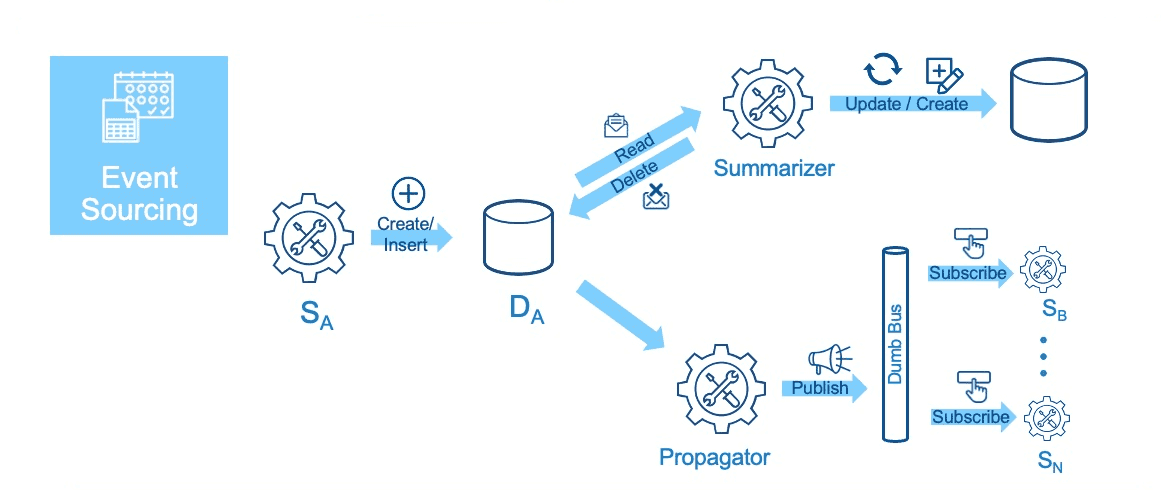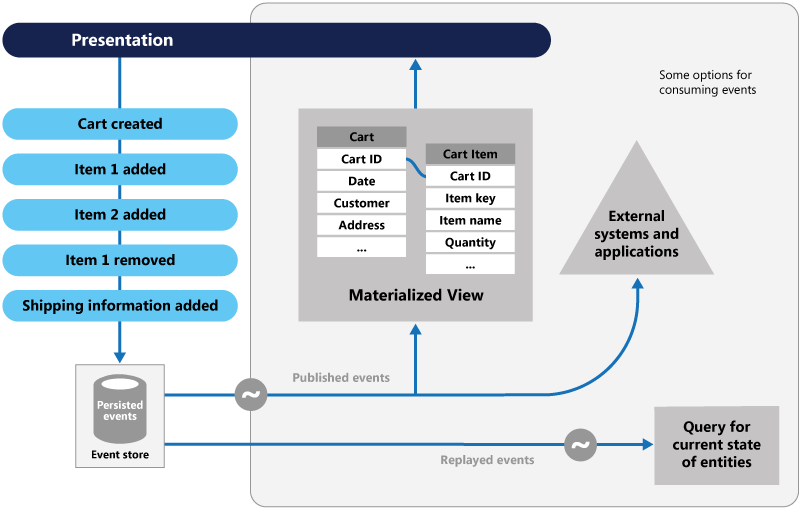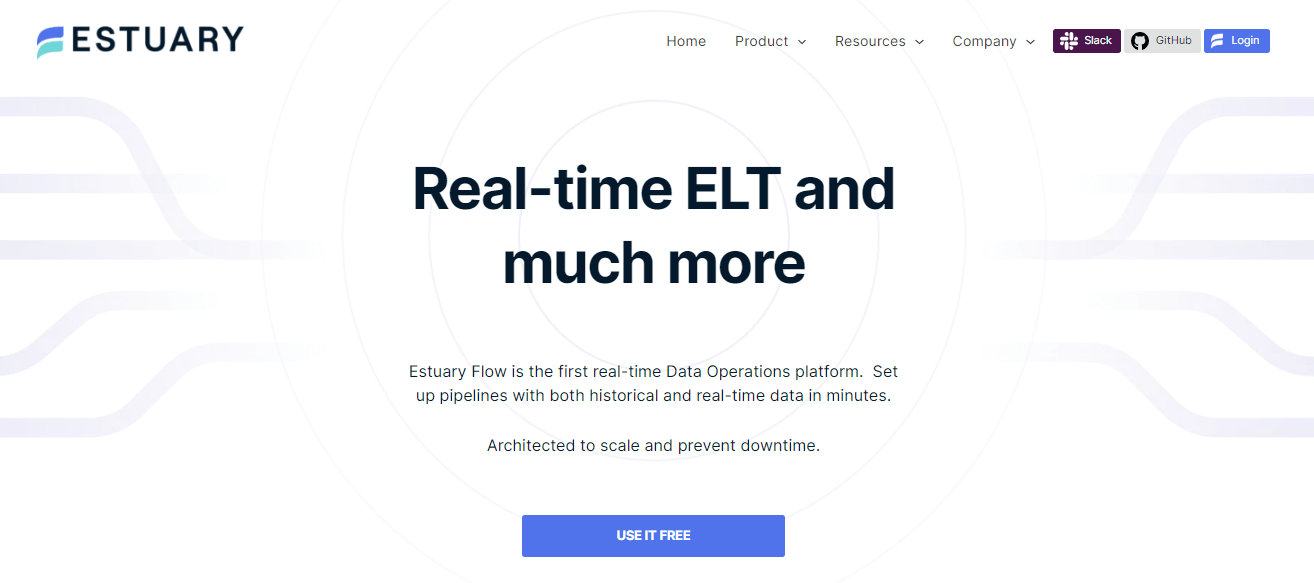
The debate of event-driven vs event sourcing is more than just a theoretical dispute in software development. It is a practical dialogue that defines our approach to data handling, event management, and the structure and operation of a modern software system.
The digital world is changing faster than ever before. Just to give you an idea, 95% of purchases are predicted to be online by 2040. With this revolutionary shift, the importance of using efficient data processing methods like event sourcing and event-driven architecture cannot be overstated.
It's exciting to think about how these architectural choices will shape the future. But with these choices comes the big question – how do you choose the most suitable architectural approach for your applications? Balancing the benefits of capturing every change with event sourcing against the agility and decoupling of event-driven architecture is a real challenge, but it doesn’t have to be.
The solution lies in understanding the major differences between these two systems and how they impact data handling, event management, and overall system design. In this guide, we will break down event sourcing and event-driven architecture, explaining what they are, how they work, and how they differ from each other.
What Is Event Sourcing?
Event sourcing is a unique system design pattern where all modifications to the application state are stored in sequence as events. It's somewhat similar to how transactional database systems operate in that it records each state change in a transaction log. However, in the context of event sourcing, an "event" signifies a "state change" more than a "notification".
The core components of event sourcing are the event stores – specialized storage spaces where the sequence of events is preserved. This system doesn't overwrite old events with new ones. Instead, it adds new events to the sequence to maintain a complete historical record of state changes.
Think about how we store information in our applications. We typically have a database where the current state of the data is stored. Event sourcing goes a step further. It tracks all actions performed on the data and stores these as domain events in chronological order. You can replay these events to understand how the current state was achieved.
For a tangible example of a default event-sourced system, think about a bank account. The present balance is the current state. To arrive at this balance, a series of transactions like deposits or withdrawals were made over time.
In the event-sourcing pattern, these transactions are the events. When you replay these transactions, you’ll see how the current balance was reached. Event sourcing is an advanced and transparent system that lets you track the evolution of the application state over time.
What Is Event-Driven Architecture (EDA)?
Event-driven architecture, often referred to as EDA, is a software design framework that focuses on components communicating through the exchange of events. The main activities in this architecture revolve around the generation, detection, handling, and response to events, which are typically defined as significant changes in state. Here, an event often takes on the role of a notification.
Distributed systems bring about a need for EDA. It's relatively easy to keep a monolithic system's components updated. But, in a distributed system, services should remain independent and loosely connected to avoid becoming a distributed monolith. In this situation, EDA comes with a big advantage.
Event-driven architecture uses events as the medium to communicate notable data changes between different service boundaries. Every new event indicates important state changes and serves as a data contract for information communication. Both the sender and receiver need to understand the message uniformly to prevent misunderstandings about the information shared.
In an event-driven architecture, a separate service, usually a message broker, keeps the services independent and loosely linked. This setup prevents the system parts from becoming too tightly connected and makes the system flexible and easy to scale. This way, event-driven architecture makes communication smooth in distributed systems and lets them react quickly to important changes.
5 Major Differences Between Event Sourcing & Event-Driven Architecture
Event sourcing and event-driven architecture are centered around events, but they differ in their focus, application, and implementation considerations. Let’s explore these differences in more detail.
Purpose & Scope: Defined Goals & Application
Event sourcing is a design pattern with a specific objective: maintaining a historical record of all state changes. This pattern is typically used within a single application or system where every state change, big or small, is saved for potential future use. The purpose? Create a reliable and accurate historical record.
Event-driven architecture has a broader scope and a different goal. This design pattern is used in multiple applications or systems and lets you build a highly scalable framework that quickly responds to changes in the environment. It's about agility, flexibility, and real-time responsiveness.
Data Storage: Centralized vs. Distributed
In Event sourcing, there's a central event store that acts as a unified database. This database records all the events, storing them in chronological order. It's like a book that records the history of state changes in the system.
Event-driven architecture takes a different approach. Its data storage is generally distributed across various components or event processors. Each component has its own storage which gives more independence and flexibility in how data is handled. Despite this, they communicate with each other to ensure smooth working.
Testability: Replay vs. Component Isolation
One of the major advantages of event sourcing is its testability. It replays the sequence of events from the start which makes it pretty straightforward to recreate a certain state or situation for testing purposes. This feature is incredibly useful when investigating issues or verifying system behavior.
Event-driven architecture, however, presents a slightly different picture. Though each component can be easily tested in isolation, testing the overall system poses challenges due to the inherent asynchronous nature of this pattern.
Handling State Changes & Business Logic: History vs. Real-Time
Event sourcing stands out in situations that require historical traceability or intricate business workflows. It's a powerful tool that does more than just auditing and debugging. It also helps in predictive analytics where it uses past data to train models for future predictions.
Event-driven architecture, in contrast, is all about providing real-time responses. It's an ideal fit for real-time monitoring, data sharing between applications, or integration of event streaming applications, allowing systems to react immediately to changes.
Complexity, Scalability, & Performance: Trade-Offs & Considerations
Implementing event sourcing can be complex because of requirements like handling events for error conditions and reconstituting state from events. Yet, it offers excellent auditability and historical consistency which makes it a popular choice in sectors like finance or healthcare.
Event-driven architecture might seem easier to implement initially but it comes with its complexities. These include maintaining eventual consistency and managing the asynchronous nature of the system. But the decoupled and distributed nature of this architecture lets it scale effectively – ideal for high-load and large-scale systems.
Event Sourcing & Event-Driven Architecture: Selecting The Right Approach
The terms "Event Sourcing" and "Event-Driven Architecture" often surface in discussions throughout the software development landscape, each bringing its own set of unique benefits and use cases. It's akin to comparing apples and oranges, as these approaches are designed to tackle different problems.
To gain a better understanding of how they fit into different scenarios, let’s dive into both of these concepts and their use cases.
Event Sourcing: Preserving The Past For A Better Future
Event sourcing comes into its own when there's a need for an exhaustive record of all state changes. If your application demands a full audit trail, an ability to debug by replaying events, or the handling of complex business workflows, it is the way to go. Here are some instances where event sourcing can prove beneficial:
Keeping A Record
If your application needs to store a detailed account of all state changes, event sourcing can serve this purpose well.
Example
In an eCommerce system, event sourcing keeps track of everything users do, like:
- Adding items to the cart
- Changing quantities
- Using coupons
- Making payments
Need For Auditability
In sectors like finance or healthcare, where a high level of auditability is a must, event sourcing can be an excellent choice.
Example
In the banking system, every transaction is stored as an event; be it a deposit, withdrawal, or transfer. This lets the bank audit financial transactions at any point.
Workflows In Business Entity
When dealing with intricate business events that need tracking, event sourcing can help trace the sequence of events leading to a particular state.
Example
An inventory management system could use event sourcing to track the state of stock over time. Every stock increase or decrease would be an event, allowing the system to trace how the stock level changed over time.
Time-Based Queries
If your system needs to perform queries related to time, the chronological order of events maintained in the event sourcing pattern fills this need.
Example
A sports analytics application can use event sourcing to store events like goals, fouls, and substitutions during a football match.
Event-Driven Architecture: Embracing Real-Time Responsiveness
Event-driven architecture is designed with quick responses and real-time data in mind. It's a fitting choice for systems that need to capture and process events as they happen. Here are some real-world examples and scenarios where EDA could be the right fit.
Real-Time Needs
If your system needs to capture and process events immediately, EDA can be the right pick.
Example
In a live chat feature of a web application, messages are events. To make the chat work properly, they should be captured and processed in real time.
Independence
For systems requiring independent, loosely-coupled components, EDA can provide the necessary flexibility.
Example
A microservices-based eCommerce application can use EDA to maintain independence among services. For instance, a 'checkout' event from the Cart Service could trigger the Order Service to create a new order, while keeping these services loosely coupled.
Scalability
If your system needs to handle high loads effectively, the distributed nature of EDA can come in handy.
Example
In a social media application, the feature to notify all friends when a user posts a new status update can benefit from EDA. With potentially thousands of friends to notify, the distributed nature of EDA can help scale the notification-sending process.
System Integration
When your application needs to communicate with different systems in real time, EDA can help with that.
Example
In an IoT system, EDA lets different devices communicate with each other in real time. For instance, a 'motion detected' event from a security camera triggers the lighting system to turn on the lights.
Combining Event Sourcing & Event-Driven Architecture
Event sourcing and event-driven architecture, while different in their functions, can team up and complement each other. One captures every data change in an event while the other uses events to communicate changes between different parts of a system.
They're different tools, but when combined, they can be extremely powerful in addressing complex problems. Let's see what can be achieved through this combination:
Data Consistency
Event sourcing is a persistence pattern, ensuring that every data change is recorded as an immutable event. These events serve as the single source of truth for the system's state. With event-driven architecture, these events are passed on to various parts of the system in a loosely coupled manner. This keeps all components up to date with the latest state changes.
Microservices Communication
Event-driven architecture is ideal for microservices-based systems. Each microservice can publish events to a message broker and interested microservices can subscribe to those events. When combined with event sourcing, microservices can receive events that represent changes to data and update their state accordingly.
CQRS (Command Query Responsibility Segregation)
Event sourcing is closely related to the CQRS pattern where commands (write operations) and queries (read operations) are handled separately. The combination of event sourcing and event-driven architecture naturally supports this separation. Events represent commands that update the state and different parts of the system can subscribe to these events to handle read operations efficiently.
Resilience & Fault Tolerance
Event-driven architectures are inherently more resilient and fault-tolerant. If a component fails to process an event, it can be retried or processed by another component without affecting the overall system. Event sourcing adds to this resilience as it can replay the events to recreate the system's state in case of a failure or to support temporal queries.
Event Versioning & Evolution
Over time, the structure of events will need improvements to accommodate changing business requirements. Event-driven architecture can handle event versioning as different consumers can adapt to different event versions. Event sourcing, with its event log history, ensures that the entire system can replay events and recreate the correct state despite changes in event structures.
A word of caution though!
While employing both event-sourcing and event-driven systems, you should be careful about how you use event objects. Using the same event objects for both could cause an unwanted dependency on your application's internal data structure. Instead, consider creating a distinct "contract" that clearly states what data will change.
This prevents any potential exposure or leak of your application's internal data and maintains the integrity and independence of your data models.
Streamlining Event-Driven Solutions With Estuary Flow
Flow by Estuary provides a platform designed to enhance the implementation of event sourcing and event-driven architecture. Let's see how Estuary Flow supports these 2 architectural patterns.
Real-Time Data Capture
With its real-time Change Data Capture (CDC), Estuary Flow captures all changes to your data which aligns perfectly with the core principle of event sourcing. This ability to record every state change as an event helps maintain a comprehensive data history.
Powering Event-Driven Architecture
Flow provides real-time transformations and data movement – ideal for event-driven architecture. It enables immediate processing and distribution of events across the system, serving the core goal of event-driven architecture – quick, efficient communication of state changes.
Scalability & Reliability
Whether it's handling extensive event logs in event sourcing or managing high loads in an event-driven system, Estuary Flow's ability to scale effectively makes it a reliable solution. Its fault-tolerant design ensures data consistency and accuracy which further boosts its reliability.
Ensuring Data Consistency
Flow's exactly-once semantics aligns with the need for data consistency in both event sourcing and event-driven architecture. It ensures the consistency of transactional database systems and provides accurate and up-to-date views of data.
Conclusion
Choosing between event-driven vs event sourcing can significantly impact the performance, scalability, and reliability of your software. Event-driven architecture can be great for real-time responsiveness and handling complex event-driven workflows. On the other hand, event sourcing is a blessing when you need to analyze past states, audit actions, or deal with issues arising from system failures.
Implementing either of these approaches requires careful consideration and planning. It's not about choosing the flashiest option but selecting the one that aligns with your system's unique needs, affecting design, data management, and fault tolerance.
This is where Estuary Flow comes into play. Our DataOps tool simplifies your data integration tasks, whether you're dealing with event sourcing, event-driven architecture, or a combination of both. It's about enhancing your capabilities, not just following trends.
So, if you are ready to take the next step, sign up for Estuary Flow here – it's free. If you have more questions or need further information on how Estuary can help you with your data needs, don't hesitate to get in touch with us. Our team of experts will help you navigate your way through the world of data management and architecture.

Author
Popular Articles














